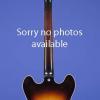An Original "Reverse" Firebird
This guitar weighs just 8.00 lbs. and has a nice, fat nut width of 1 11/16 inches and a standard Gibson scale length of 24 3/4 inches. Solid mahogany body, mahogany, neck, and bound rosewood fretboard with 22 jumbo frets and inlaid pearl dot position markers. Headstock with gold-painted "Gibson" logo on black plastic truss-rod cover. Individual Gibson Banjo-style tuners with rearwards metal tulip-shaped buttons. Two "patent number" mini-humbuckers with outputs of 6.69k and 6.15k. Three-layer (white/black/white) plastic pickguard with a "Firebird" emblem painted on in red. Four controls (two volume, two tone) plus three-way selector switch. Gold plastic bell-shaped knobs with metal tops. Combination bar bridge/tailpiece with pre-set ridges and short Vibrola tailpiece with flat metal lever. All parts nickel-plated. The pots are dated "137 64 48." There is some finish checking, some minor tarnishing to the nickel hardware, a few very minor marks on the edges (especially on the bottom edge), and a small repaired crack at the tip of the pickguard. Otherwise this guitar is near mint -- bloody wonderful! Housed in its original Gibson black hardshell case with orange plush lining (9.00).
"Announced in Spring 1963, the original Firebird series was conceived as an attempt to produce less conventional electrics likely to appeal to Fender players. Four different models, identified by odd Roman numerals, were marketed simultaneously...The four models produced between 1963 and 1965 (a.k.a. the 'reverse' Firebirds) share the same body specifications and differ only in fretboard style, electronics and hardware...The original Firebird electrics are primarily characterized by: a neck-through-body construction; a reverse body shape with extended lower horn; a reverse peghead with the treble E tuner nearest to the nut; banjo-style tuners with rearwards buttons; and they are all equipped with mini-humbuckers built without adjustable polepieces. The early samples are characterized by a 2-piece full length neck and a convex heel where the neck blends into the body. By late 1963, production models were released with a stronger 9-piece lamination and a smaller squared-off heel. A painted-on red Firebird emblem was also added on the white pickguard...For all practical purposes, the Firebird III was the equivalent of the Special found in the SG/Les Paul family. Compared to the FB I, the model is characterized by: a bound rosewood fingerboard; two pickups; individual volume and tone controls for each pickup; a 3-way toggle switch for pickup selection; a (short) Vibrola tailpiece with flat metal lever. In spite of a Vibrola tailpiece, the FB III sports the same bar bridge with a pre-set ridge as the FB I. And because of its stud-anchoring this bridge cannot be replaced by a fully adjustable Tune-O-Matic bridge...The original Firebird series remained in production for less than two years" (A.R. Duchossoir, Gibson Electrics -- The Classic Years, pp. 198-199).
Translate:

